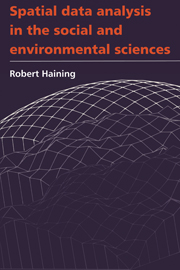Book contents
- Frontmatter
- Contents
- List of tables and displays
- Preface
- Acknowledgements
- PART A Introduction to issues in the analysis of spatially referenced data
- PART B Parametric models for spatial variation
- PART C Spatial data collection and preliminary analysis
- PART D Modelling spatial data
- Postscript
- Glossary
- References
- Index
Postscript
Published online by Cambridge University Press: 05 August 2012
- Frontmatter
- Contents
- List of tables and displays
- Preface
- Acknowledgements
- PART A Introduction to issues in the analysis of spatially referenced data
- PART B Parametric models for spatial variation
- PART C Spatial data collection and preliminary analysis
- PART D Modelling spatial data
- Postscript
- Glossary
- References
- Index
Summary
Chapter 1 defined three important objectives: the presentation of spatial data analysis as a part of general data analysis while alerting the reader to the special difficulties that spatial data may create; the presentation of a wide range of models for presenting spatial variation; the examination of the role of subject matter theory in spatial analysis. Good data analysis seeks a balance between being theoretically informed and letting the data speak. Balance is essential in order to avoid the twin problems of on the one hand using data analysis merely to confirm existing prejudices and on the other reporting ambiguous data patterns. We offer some observations to conclude the book that relate to these issues.
From a technical point of view some of the most serious difficulties facing the analyst of spatial data concern the wide range of possible data models and the need to implement awkward and laborious fitting procedures. The availability of specialist software that implements the fitting and evaluation of spatial models is desirable. But important though it is to develop specialist software for confirmatory spatial data analysis it should be evident that useful progress can be made by carrying out sensible exploratory analyses with standard software. Some pre-processing of the data may be necessary but thereafter simple graphical and resistant techniques of analysis can offer useful insights into the data, indicating the types of models that should be explored and hence determining the extent to which specialist software is needed in order to carry out confirmatory analyses.
- Type
- Chapter
- Information
- Spatial Data Analysis in the Social and Environmental Sciences , pp. 386 - 388Publisher: Cambridge University PressPrint publication year: 1990

